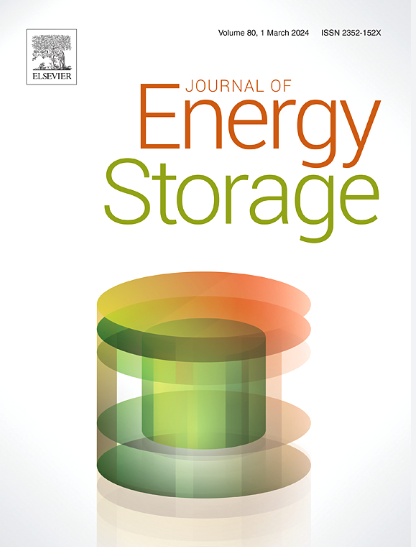生物有机相变材料混合物填充空心砖热效率研究
IF 8.9
2区 工程技术
Q1 ENERGY & FUELS
引用次数: 0
摘要
提出了一种生物有机相变材料(BIO-PCMs)来取代目前在建筑中使用的石油基PCMs,特别是在以干旱气候而闻名的Adrar市。脂肪酸的检测基于几个标准,如价格、可获得性、风险和可再生来源。在硬脂酸和肉豆蔻酸的基础上,确定了一种适合PCM的脂肪酸候选者。为了研究所提出的PCMs的热性能,制备了肉豆汁酸和硬脂酸的共晶混合物,并以不同的比例合成了一系列混合物。以70%肉豆蔻酸(MA)和30%硬脂酸(SA)为原料,优选出一种具有高热稳定性和有效储能性能的复合材料。差示扫描量热法实验测试证实其熔化温度为35℃。利用COMSOL Multiphysics软件进行了一项数值研究,以量化在阿尔及利亚撒哈拉沙漠酷暑条件下将实验选择的pcm纳入砖墙的热效应。设计了两种墙体结构进行比较:一种是将PCM集成到砖结构中,另一种是作为参考,没有PCM。结果表明,将PCM放置在外壁面附近可使室内温度降低2.8°C,并将换热峰值延迟2小时。此外,与没有PCM的空心粘土墙相比,这种结构的内表面热流密度减少了58%。这项研究证实了它适合像Adrar这样的炎热气候,并有可能在不同的季节条件下进一步优化。本文章由计算机程序翻译,如有差异,请以英文原文为准。
Investigation of the thermal efficiency of hollow bricks filled with bio-organic phase change material mixture
A bio-organic phase change material (BIO-PCMs) is proposed to replace petroleum-based PCMs currently used in buildings, specifically for application in the city of Adrar, known for its arid climate. Fatty acids were examined based on several criteria, such as price, availability, risks, and renewable origin. A suitable fatty acid candidate for the PCM, based on stearic and myristic acids, was identified. To investigate the thermal properties of the proposed PCMs, eutectic mixtures of myristic and stearic acids were prepared and synthesized in a series of mixtures with different proportions. An optimal PCM composition of 70 % myristic acid (MA) and 30 % stearic acid (SA) was developed, offering high thermal stability and effective energy storage. Experimental testing using differential scanning calorimetry confirmed its melting temperature at 35 °C. A numerical investigation using COMSOL Multiphysics software was also conducted to quantify the thermal effect of incorporating the experimentally selected PCMs into a brick wall under severely hot summer conditions in Algeria's Sahara. Two wall configurations were designed for comparison: one in which the PCM was integrated into the brick structure, and the other serving as a reference without PCM. The results showed that placing the PCM near the outer wall surface lowered indoor temperatures by 2.8 °C and delayed peak heat transfer by 2 hours. Also, there was 58 % reduction in inner surface heat flux for this configuration when ccompared with hollow clay wall without PCM. The study confirmed its suitability for hot climates like Adrar, with potential for further optimization in varying seasonal conditions.
求助全文
通过发布文献求助,成功后即可免费获取论文全文。
去求助
来源期刊

Journal of energy storage
Energy-Renewable Energy, Sustainability and the Environment
CiteScore
11.80
自引率
24.50%
发文量
2262
审稿时长
69 days
期刊介绍:
Journal of energy storage focusses on all aspects of energy storage, in particular systems integration, electric grid integration, modelling and analysis, novel energy storage technologies, sizing and management strategies, business models for operation of storage systems and energy storage developments worldwide.
 求助内容:
求助内容: 应助结果提醒方式:
应助结果提醒方式:


